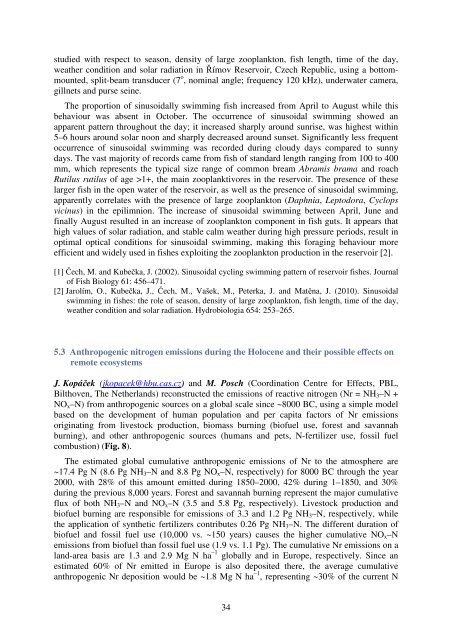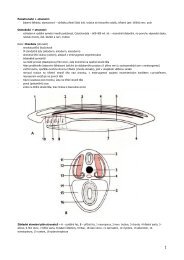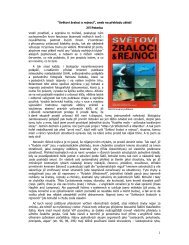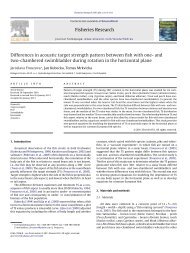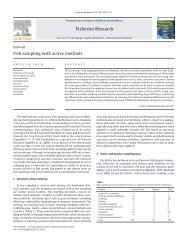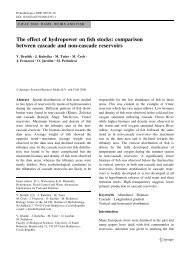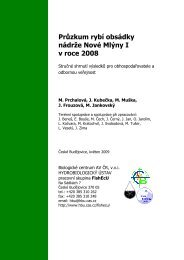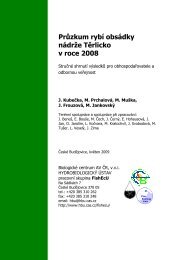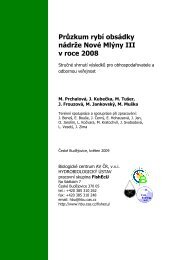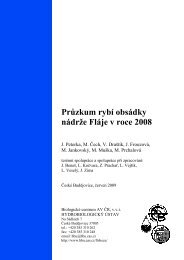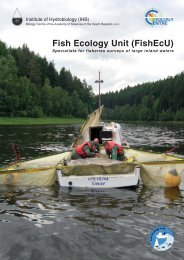anglicky - Institute of Hydrobiology
anglicky - Institute of Hydrobiology
anglicky - Institute of Hydrobiology
You also want an ePaper? Increase the reach of your titles
YUMPU automatically turns print PDFs into web optimized ePapers that Google loves.
studied with respect to season, density <strong>of</strong> large zooplankton, fish length, time <strong>of</strong> the day,<br />
weather condition and solar radiation in Římov Reservoir, Czech Republic, using a bottommounted,<br />
split-beam transducer (7 o , nominal angle; frequency 120 kHz), underwater camera,<br />
gillnets and purse seine.<br />
The proportion <strong>of</strong> sinusoidally swimming fish increased from April to August while this<br />
behaviour was absent in October. The occurrence <strong>of</strong> sinusoidal swimming showed an<br />
apparent pattern throughout the day; it increased sharply around sunrise, was highest within<br />
5–6 hours around solar noon and sharply decreased around sunset. Significantly less frequent<br />
occurrence <strong>of</strong> sinusoidal swimming was recorded during cloudy days compared to sunny<br />
days. The vast majority <strong>of</strong> records came from fish <strong>of</strong> standard length ranging from 100 to 400<br />
mm, which represents the typical size range <strong>of</strong> common bream Abramis brama and roach<br />
Rutilus rutilus <strong>of</strong> age >1+, the main zooplanktivores in the reservoir. The presence <strong>of</strong> these<br />
larger fish in the open water <strong>of</strong> the reservoir, as well as the presence <strong>of</strong> sinusoidal swimming,<br />
apparently correlates with the presence <strong>of</strong> large zooplankton (Daphnia, Leptodora, Cyclops<br />
vicinus) in the epilimnion. The increase <strong>of</strong> sinusoidal swimming between April, June and<br />
finally August resulted in an increase <strong>of</strong> zooplankton component in fish guts. It appears that<br />
high values <strong>of</strong> solar radiation, and stable calm weather during high pressure periods, result in<br />
optimal optical conditions for sinusoidal swimming, making this foraging behaviour more<br />
efficient and widely used in fishes exploiting the zooplankton production in the reservoir [2].<br />
[1] Čech, M. and Kubečka, J. (2002). Sinusoidal cycling swimming pattern <strong>of</strong> reservoir fishes. Journal<br />
<strong>of</strong> Fish Biology 61: 456–471.<br />
[2] Jarolím, O., Kubečka, J., Čech, M., Vašek, M., Peterka, J. and Matěna, J. (2010). Sinusoidal<br />
swimming in fishes: the role <strong>of</strong> season, density <strong>of</strong> large zooplankton, fish length, time <strong>of</strong> the day,<br />
weather condition and solar radiation. Hydrobiologia 654: 253–265.<br />
5.3 Anthropogenic nitrogen emissions during the Holocene and their possible effects on<br />
remote ecosystems<br />
J. Kopáček (jkopacek@hbu.cas.cz) and M. Posch (Coordination Centre for Effects, PBL,<br />
Bilthoven, The Netherlands) reconstructed the emissions <strong>of</strong> reactive nitrogen (Nr = NH 3 –N +<br />
NO x –N) from anthropogenic sources on a global scale since ~8000 BC, using a simple model<br />
based on the development <strong>of</strong> human population and per capita factors <strong>of</strong> Nr emissions<br />
originating from livestock production, biomass burning (bi<strong>of</strong>uel use, forest and savannah<br />
burning), and other anthropogenic sources (humans and pets, N-fertilizer use, fossil fuel<br />
combustion) (Fig. 8).<br />
The estimated global cumulative anthropogenic emissions <strong>of</strong> Nr to the atmosphere are<br />
~17.4 Pg N (8.6 Pg NH 3 –N and 8.8 Pg NO x –N, respectively) for 8000 BC through the year<br />
2000, with 28% <strong>of</strong> this amount emitted during 1850–2000, 42% during 1–1850, and 30%<br />
during the previous 8,000 years. Forest and savannah burning represent the major cumulative<br />
flux <strong>of</strong> both NH 3 –N and NO x –N (3.5 and 5.8 Pg, respectively). Livestock production and<br />
bi<strong>of</strong>uel burning are responsible for emissions <strong>of</strong> 3.3 and 1.2 Pg NH 3 –N, respectively, while<br />
the application <strong>of</strong> synthetic fertilizers contributes 0.26 Pg NH 3 –N. The different duration <strong>of</strong><br />
bi<strong>of</strong>uel and fossil fuel use (10,000 vs. ~150 years) causes the higher cumulative NO x –N<br />
emissions from bi<strong>of</strong>uel than fossil fuel use (1.9 vs. 1.1 Pg). The cumulative Nr emissions on a<br />
land-area basis are 1.3 and 2.9 Mg N ha –1 globally and in Europe, respectively. Since an<br />
estimated 60% <strong>of</strong> Nr emitted in Europe is also deposited there, the average cumulative<br />
anthropogenic Nr deposition would be ~1.8 Mg N ha –1 , representing ~30% <strong>of</strong> the current N<br />
34


